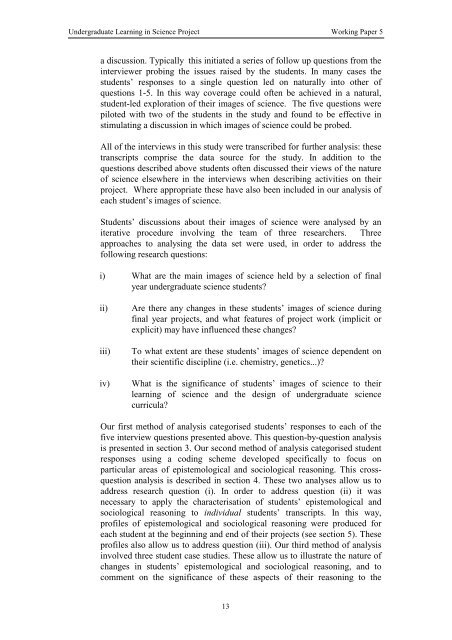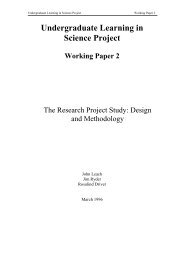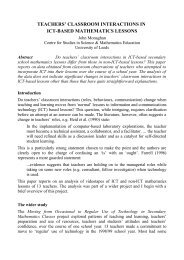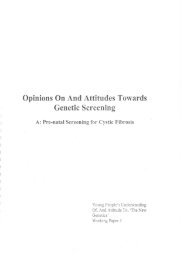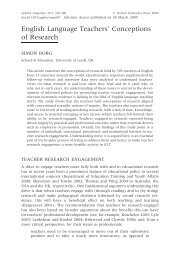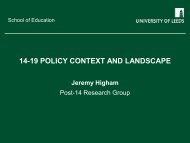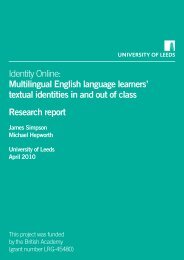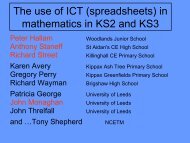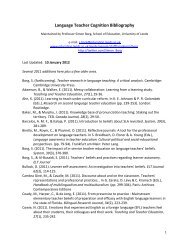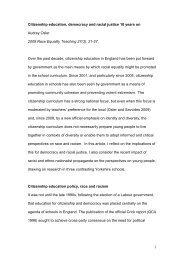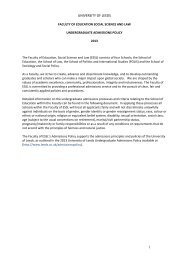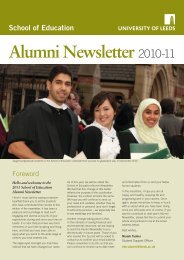Undergraduate science research projects and students - School of ...
Undergraduate science research projects and students - School of ...
Undergraduate science research projects and students - School of ...
Create successful ePaper yourself
Turn your PDF publications into a flip-book with our unique Google optimized e-Paper software.
<strong>Undergraduate</strong> Learning in Science Project Working Paper 5a discussion. Typically this initiated a series <strong>of</strong> follow up questions from theinterviewer probing the issues raised by the <strong>students</strong>. In many cases the<strong>students</strong>’ responses to a single question led on naturally into other <strong>of</strong>questions 1-5. In this way coverage could <strong>of</strong>ten be achieved in a natural,student-led exploration <strong>of</strong> their images <strong>of</strong> <strong>science</strong>. The five questions werepiloted with two <strong>of</strong> the <strong>students</strong> in the study <strong>and</strong> found to be effective instimulating a discussion in which images <strong>of</strong> <strong>science</strong> could be probed.All <strong>of</strong> the interviews in this study were transcribed for further analysis: thesetranscripts comprise the data source for the study. In addition to thequestions described above <strong>students</strong> <strong>of</strong>ten discussed their views <strong>of</strong> the nature<strong>of</strong> <strong>science</strong> elsewhere in the interviews when describing activities on theirproject. Where appropriate these have also been included in our analysis <strong>of</strong>each student’s images <strong>of</strong> <strong>science</strong>.Students’ discussions about their images <strong>of</strong> <strong>science</strong> were analysed by aniterative procedure involving the team <strong>of</strong> three <strong>research</strong>ers. Threeapproaches to analysing the data set were used, in order to address thefollowing <strong>research</strong> questions:i) What are the main images <strong>of</strong> <strong>science</strong> held by a selection <strong>of</strong> finalyear undergraduate <strong>science</strong> <strong>students</strong>?ii)iii)iv)Are there any changes in these <strong>students</strong>’ images <strong>of</strong> <strong>science</strong> duringfinal year <strong>projects</strong>, <strong>and</strong> what features <strong>of</strong> project work (implicit orexplicit) may have influenced these changes?To what extent are these <strong>students</strong>’ images <strong>of</strong> <strong>science</strong> dependent ontheir scientific discipline (i.e. chemistry, genetics...)?What is the significance <strong>of</strong> <strong>students</strong>’ images <strong>of</strong> <strong>science</strong> to theirlearning <strong>of</strong> <strong>science</strong> <strong>and</strong> the design <strong>of</strong> undergraduate <strong>science</strong>curricula?Our first method <strong>of</strong> analysis categorised <strong>students</strong>’ responses to each <strong>of</strong> thefive interview questions presented above. This question-by-question analysisis presented in section 3. Our second method <strong>of</strong> analysis categorised studentresponses using a coding scheme developed specifically to focus onparticular areas <strong>of</strong> epistemological <strong>and</strong> sociological reasoning. This crossquestionanalysis is described in section 4. These two analyses allow us toaddress <strong>research</strong> question (i). In order to address question (ii) it wasnecessary to apply the characterisation <strong>of</strong> <strong>students</strong>’ epistemological <strong>and</strong>sociological reasoning to individual <strong>students</strong>’ transcripts. In this way,pr<strong>of</strong>iles <strong>of</strong> epistemological <strong>and</strong> sociological reasoning were produced foreach student at the beginning <strong>and</strong> end <strong>of</strong> their <strong>projects</strong> (see section 5). Thesepr<strong>of</strong>iles also allow us to address question (iii). Our third method <strong>of</strong> analysisinvolved three student case studies. These allow us to illustrate the nature <strong>of</strong>changes in <strong>students</strong>’ epistemological <strong>and</strong> sociological reasoning, <strong>and</strong> tocomment on the significance <strong>of</strong> these aspects <strong>of</strong> their reasoning to the13


